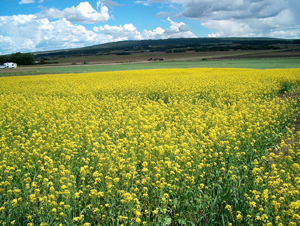
Features
Agronomy
Seeding/Planting
Research trying to link agronomics to seed performance
Does seeding and harvest date affect certified canola seed production?
November 29, 2007 By Bruce Barker
Canola growers constantly struggle to achieve optimal stand establishment.
Deep seeding, cold soils, dry soil moisture, seedling disease and soil crusting
can all impact germination and emergence. To help stack the odds in favour of
canola, seeding adequate rates of seed that is high in germination is an important
strategy, in the absence of a standard seed vigour test.
Murray Hartman, provincial oilseed specialist with Alberta Agriculture, Food
and Rural Development at Edmonton, says there are a number of factors that can
influence viability and vigour, such as genetics, degree of maturity, conditions
during seed development and maturation, mechanical factors during harvest and
transport, storage conditions and seedborne diseases. He reviewed research from
various sources to see if maturity of the Mother crop (the crop producing seed
for commercial farmers) had an impact on subsequent germination and seedling
vigour.
 |
| Research has been unable to find a consistent relationship between seed performance and Mother crop management. |
"While it is common knowledge that maximum germination and vigour come
from seed that has reached full maturity without stress, the exact impact of
newer practices on seed quality has not been well documented," explains
Hartman. "Could early seeding dates reduce stresses experienced during
seed maturation and thus influence seeding quality? And could swathing at more
mature plant stages increase seed quality?"
Hartman says that recent research from Larry Gusta conducted at the Agriculture
and Agri-Food Canada Scott Research Farm in Saskatchewan reported that seed
harvested from fall or early spring sown Mother crops had better emergence,
seedling vigour and yield than May sown Mother crops. The quality of the May
Mother crop also deteriorated more over a two year period.
In the research, canola seed harvested from the Mother crops was seeded on
the same date the following year. "From this research, it looks like early
spring seeding of the Mother crop could produce better seed," says Hartman.
Other research by research scientist, Eric Johnson at AAFC Scott also showed
that fall and early spring seeding of the Mother crop produced larger seed.
Since seed size has been related to seedling vigour in many crops, Hartman says
that the large seed size from early seeded Mother crops was the expected reason
for the better performance of subsequent crops. However, when seed size was
accounted for, the effect disappeared.
"That got me thinking that the maturity of the crop at harvest has an
impact, because of stresses during maturation," says Hartman.
He next turned to research conducted by research scientist Bob Elliott at AAFC
Saskatoon. Elliott has been on a quest to find a seedling vigour test for canola
and in the process of his research, conducted field studies looking at seedling
emergence, seedling establishment, plant weight and biomass (see Canola seed
index predicts field performance, page 18).
After analyzing Elliott's data, Hartman could not find any real effect between
May and June plantings of the Mother crop.
| Spring seeded canola performance in response to Mother crop seeding date (Scott, Saskatchewan). |
||||
| Seed source | Plants per square metre |
Emergence (percentage) |
Biomass at bolting (kg/ha) | Yield (bu/ac) |
| Fall 1997 | 40 | 27 | 258 | 41.5 |
| April 1998 | 35 | 23 | 242 | 42.6 |
| May 1998 | 30 | 20 | 60 | 24.6 |
| Fall 1998 | 58 | 39 | 268 | 49.5 |
| April 1999 | 45 | 30 | 264 | 49.6 |
| May 1999 | 51 | 34 | 200 | 39.1 |
| Source: AAFC, Gusta et al, 2004. | ||||
"Those results are different than Gusta's at Scott. If the research was
done over a large number of years, there might be a correlation between seeding
date of the Mother crop and seed quality," explains Hartman. "But
we don't want to start sorting seed lots by harvest or seed date. While some
of the research is conflicting, it shows that the scientific process is important
in sorting out these types of parameters."
In addition to seed size, fall and April seed were 59 to 70 percent mature,
compared to May seed, which was only 16 to 24 percent mature. Mature seed has
a seed coat with black/dark purple colour and smooth to ridged texture. Immature
seed coat colour ranges from orange-brown to yellow-green, with a ridged to
mis-shaped texture. Hartman says that more mature seed may have increased levels
of stress tolerance proteins.
In laboratory research in Michigan, later harvested canola had better germination.
However, Hartman says that was not borne out in the field at Melfort and Scott
where other research by Elliott showed that swathing date of the Mother crop
had no affect on emergence, biomass or yield.
What it means to farmers
While early seeding and late swathing of the Mother crop can produce higher
quality seed for planting – larger, more mature seed – Hartman says
that farmers should focus on the current tests available, and a visual inspection
of the seed, rather than on the actual agronomic management of the Mother crop.
Visual inspection of seed for mature seed coat colour, smooth texture, low green
seed count and plump size can complement information from germination and vigour
tests.
While visual characteristics may not be available prior to seed purchase, Hartman
says it could allow producers to estimate possible mortality at seeding time
and allow fine-tuning of management practices such as seeding rate, fertilizer
placement and seeding depth.
"One thousand kernel weight, or plumpness, could be important, as well
as a visual inspection for sound seed," says Hartman.